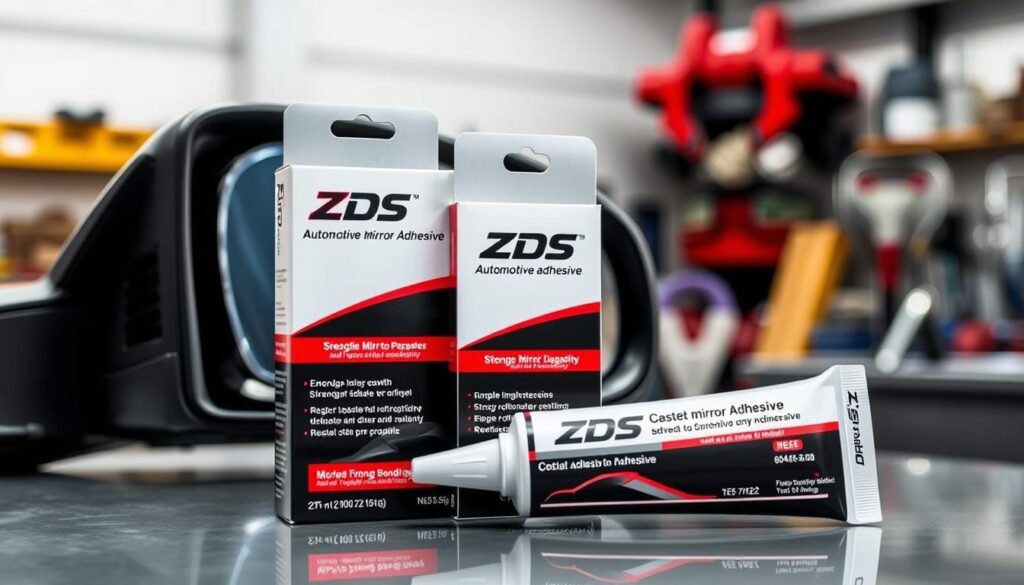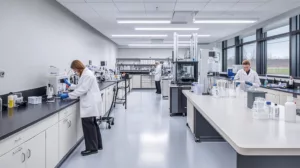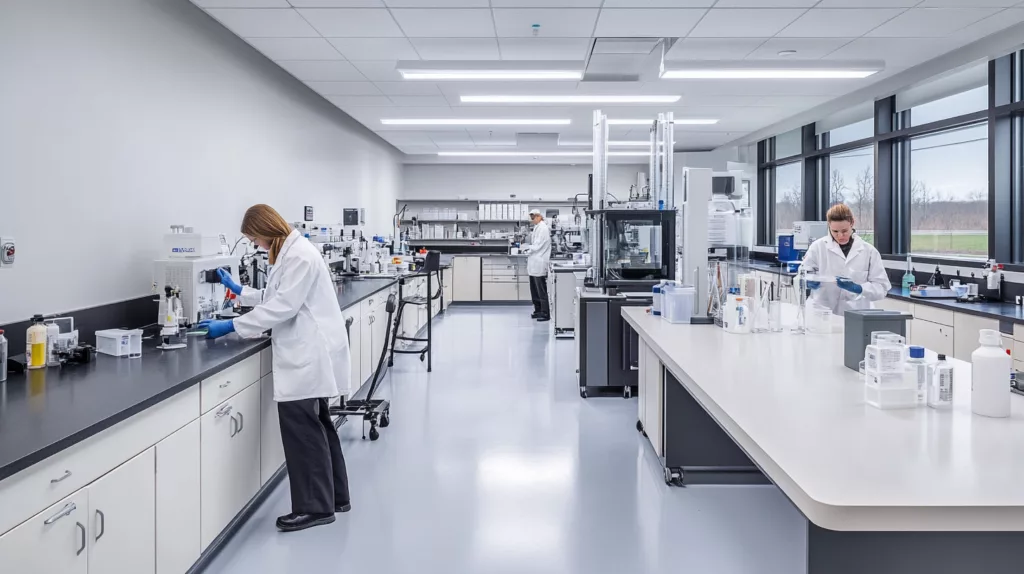In today’s fast-changing auto world, choosing the right mirror adhesive is key for safety. At ZDS™, we know that a good adhesive does more than just stick mirrors. It makes sure you see well while driving.
The adhesive market for car mirrors has grown a lot, with options for all kinds of uses. This article will help you find the best adhesives for 2024. It aims to help you make choices that fit both professional and DIY projects. Learn more about choosing adhesives in our guide on adhesive selection.
Key Takeaways
- Choosing the best adhesive for automotive mirrors ensures safety and optimal performance.
- Understanding the types of automotive mirror adhesives available can help in making an informed choice.
- High-quality adhesive for automotive mirrors can enhance visibility and longevity.
- Proper application techniques are essential for achieving strong bonds.
- Consider environmental factors that may affect adhesive performance.
- Stay updated on the latest advancements in adhesive technologies.
Understanding the Importance of Automotive Mirror Adhesive
Automotive mirrors help keep driving safe. It’s important to choose the right adhesive for them. A strong adhesive keeps mirrors in place, which helps avoid accidents by stopping them from moving or falling off.
Good mirror adhesive does more than just stick. It creates a lasting bond, cutting down on the need for repairs. With mirrors securely in place, drivers feel confident that they can see clearly.
Mirrors’ adhesives must also face weather challenges. They’re made to resist changes in temperature, UV rays, and moisture. This makes the adhesive last longer, working well in different conditions.
Using the proper adhesive makes driving safer and improves a car’s performance. For more information on the best automotive adhesives for plastic parts, click on our detailed guide.
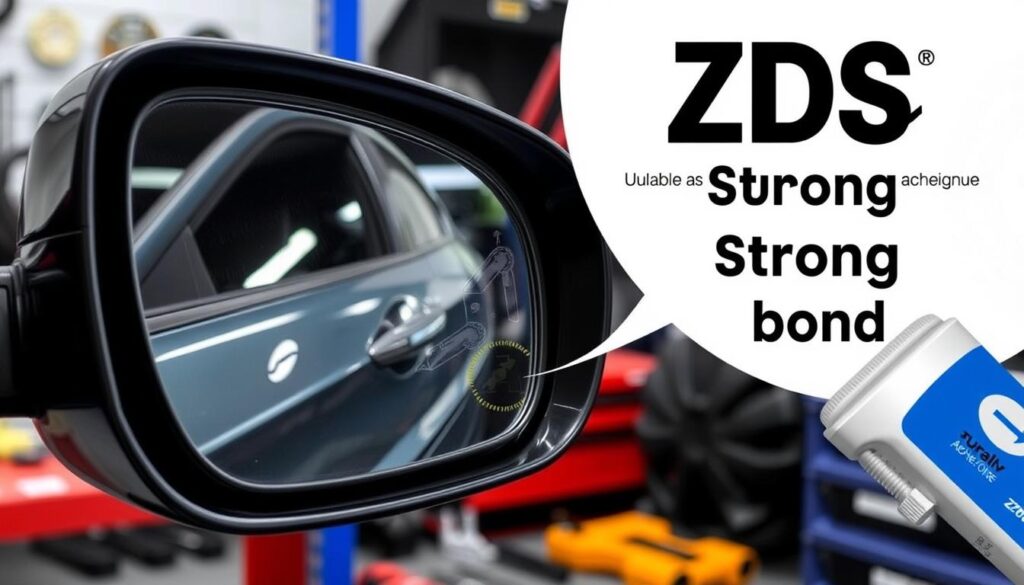
Types of Adhesives for Automotive Mirrors
When choosing adhesives for automotive mirrors, knowing the different types matters. Each kind has unique qualities for special uses in cars.
Overview of Common Adhesive Types
Let’s look at the main adhesives used for car mirrors:
- Epoxy Adhesives: They’re strong and fast-setting, best for taking on heavy bumps. They’re a top pick.
- Silicone Adhesives: These are flexible and keep water out. They’re great for outside use because they handle weather well.
- Acrylic Adhesives: Known for their clear look and toughness, they’re ideal for glass parts on cars.
Pros and Cons of Each Type
It’s key to weigh each adhesive’s good and bad points for your car mirror needs.
| Adhesive Type | Advantages | Disadvantages |
|---|---|---|
| Epoxy Adhesives | Strong bond, handles heat well | Takes longer to set, might crack under too much pressure |
| Silicone Adhesives | Stays flexible, water can’t get through | Not as strong in holding as others |
| Acrylic Adhesives | Sets quickly, easy to use | Can’t take as much knocking around as epoxy |
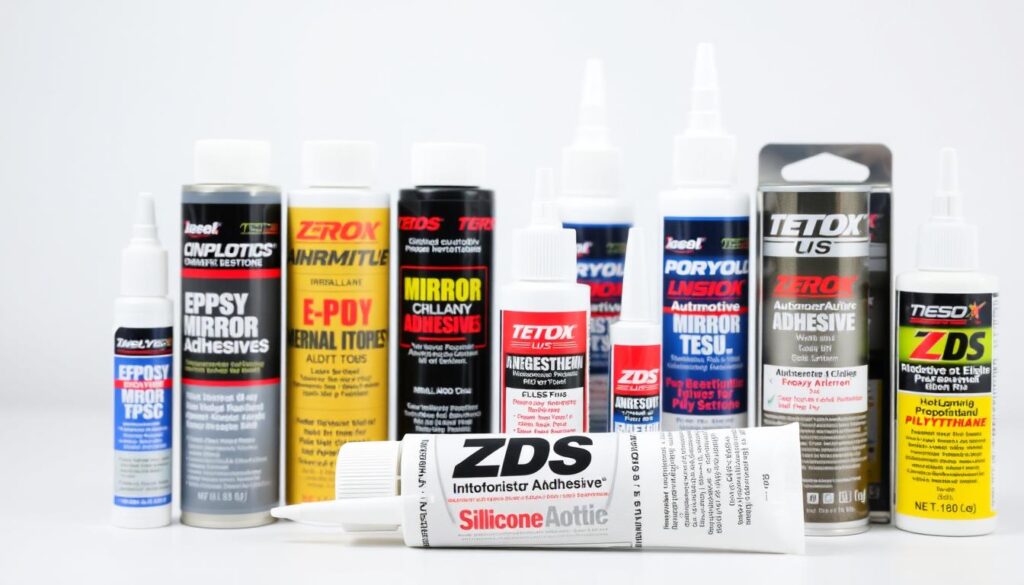
Best Adhesive for Automotive Mirrors
Finding the right adhesive for car mirrors is key. Look for products that are top performers and have great reviews. We’ve checked out several options and found the best ones for professionals and hobbyists alike.
Overview of Top-Rated Products
A few adhesives stand out for sticking mirrors well. They have earned praise for their strong hold. Here are some top picks:
- 3M Rearview Mirror Adhesive: Made for rearview mirrors, it’s known for a tough bond and easy use.
- Loctite Glass Glue: This top-notch adhesive works well for many mirror types. It’s great for sticking glass to glass.
- Permatex Mirror Adhesive: It dries quickly, making it a go-to for rapid repairs.
Key Features to Look For
Choosing a rearview mirror adhesive? Look for these features:
- Bond Strength: You need a strong adhesive to keep mirrors in place.
- Cure Time: Quick-drying options make installation easier.
- Environmental Resistance: Pick adhesives that can handle weather changes and moisture, especially for mirrors outside.

| Product Name | Bond Strength | Cure Time | Environmental Resistance |
|---|---|---|---|
| 3M Rearview Mirror Adhesive | High | Fast-drying | Excellent |
| Loctite Glass Glue | Durable | Moderate | Good |
| Permatex Mirror Adhesive | Strong | Very fast | Good |
Strong Adhesive for Car Mirrors: What Makes It Strong?
A strong adhesive for car mirrors is crucial for safety and functionality. It withstands tough conditions thanks to various factors. Knowing these factors helps pick the best adhesive for car mirrors.
Factors that Contribute to Strength
Several elements boost the power of car mirror adhesives:
- Chemical Composition: Advanced formulas like epoxies enhance strength.
- Application Technique: Proper application improves performance.
- Curing Environment: The right curing conditions strengthen the bond.
Testing Adhesive Strength for Automotive Use
Tests confirm the reliability of automotive adhesives:
- Peel Tests: These check adhesion in real-like situations.
- Shear Tests: They see how adhesives handle load.
- Environmental Conditioning: This tests durability against weather and more.
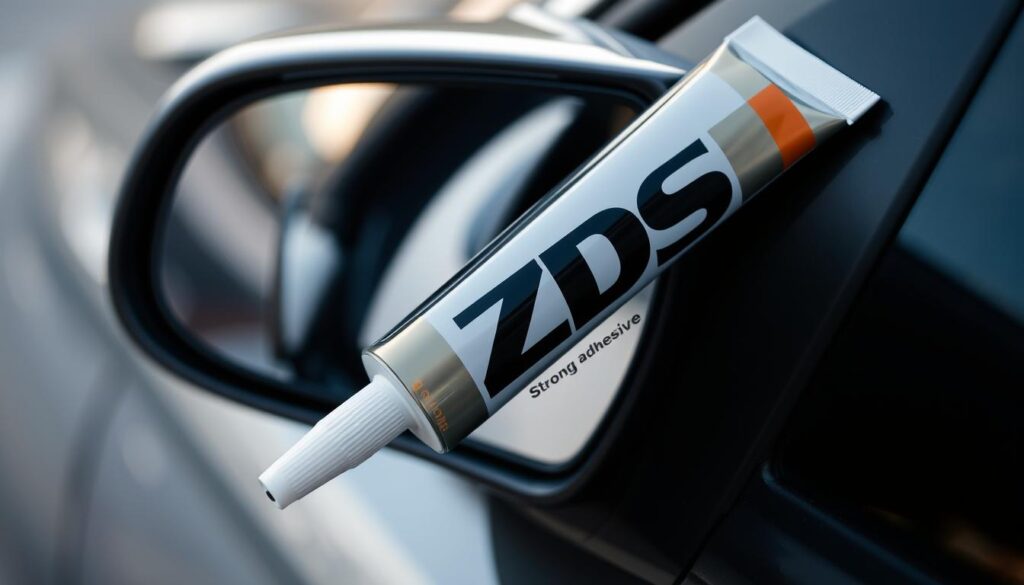
| Testing Method | Description | Purpose |
|---|---|---|
| Peel Tests | Measures the force needed to peel adhesive from a surface | Determines bond integrity |
| Shear Tests | Assesses the adhesive’s ability to resist sliding forces | Evaluates performance under stress |
| Environmental Conditioning | Tests adhesive exposure to various environmental factors | Predicts long-term durability |
Choosing Automotive Mirror Adhesive: Key Considerations
Finding the perfect automotive mirror adhesive is key for lasting strength and performance. Look into surface compatibility, temperature handling, and the time it cures.
Surface Compatibility
When picking an adhesive for car mirrors, knowing what materials you’re working with is crucial. The bonding success greatly depends on if the surfaces match well. Important points include:
- Material Compatibility: Make sure the adhesive sticks well to glass, plastic, or metal.
- Surface Preparation: Always clean the surfaces to remove dirt or oil first.
Temperature Resistance
Being able to withstand different temperatures is vital for a car adhesive. Opt for labels that prove their adhesives hold up under varied conditions. This ensures they last longer, especially in places with changing weather.
Cure Time and Application Method
It’s important to know how and how quickly an adhesive sets. Adhesives that cure fast make the job easier and quicker. To find reliable products, check out what ZDS™ offers—they’re known for their specialized adhesive solutions.

Comparative Analysis of Top Adhesives for Car Mirrors
We look at two main brands when it comes to car mirror adhesives: 3M and Loctite. Each brand is known for quality, but they have different strengths. Knowing these differences helps choose the right adhesive for your car mirror needs.
Brand 1 vs. Brand 2
3M stands out for its strong bond and easy usage. It’s the go-to for many because it works well under tough conditions. Loctite, however, shines with its versatile application and durability.
| Feature | 3M | Loctite |
|---|---|---|
| Bonding Performance | High strength and durability | Excellent flexibility |
| Application Ease | Simple and efficient | Requires careful handling |
| User Feedback | Positive reviews for tough conditions | Recommended for diverse applications |
| Manufacturing Consistency | Widely trusted and proven | Quality noted across various applications |
Price vs. Quality: What to Expect?
When picking the right adhesive for car mirrors, price matters. More expensive adhesives may have special ingredients that boost performance. However, cheaper options can be good for easy tasks, but might not last as long. Understanding the price and quality of car mirror adhesives aids in smart buying.
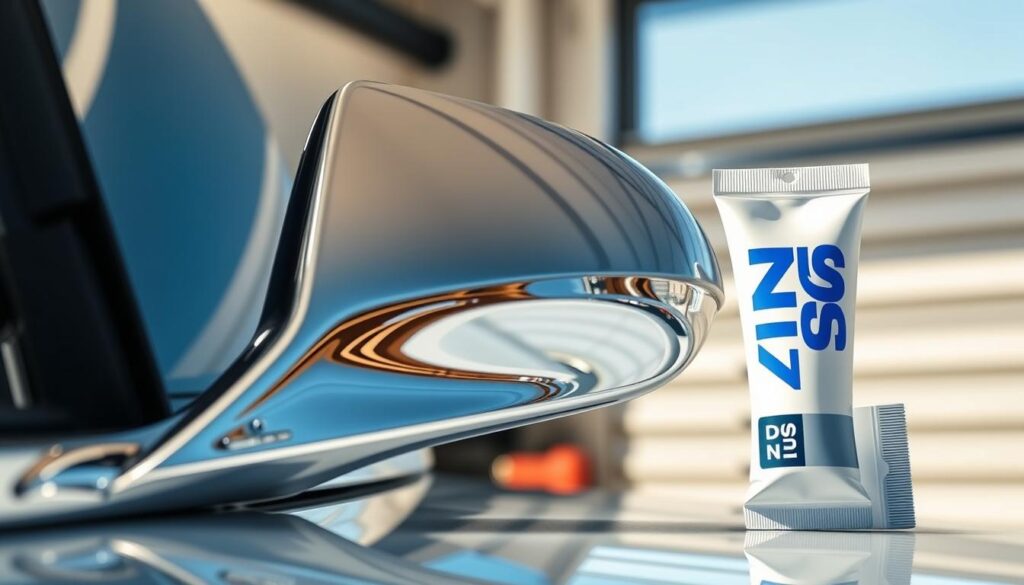
How to Properly Apply Mirror Adhesive
Applying automotive mirror adhesive is a precise task. It needs your full attention to ensure a strong, lasting bond. The process has several key steps you should follow. Knowing these steps helps avoid common mistakes that could weaken the bond.
Step-by-Step Application Process
- Prepare the Surface: Clean the mirror and the application area well to remove any dust or debris.
- Apply Adhesive: Use the right amount of adhesive for rearview mirrors, spreading it evenly without spills.
- Secure Positioning: Keep the mirror in place until the adhesive sets by holding or clamping it.
- Curing Time: Allow the adhesive to cure as recommended by the manufacturer before you drive the vehicle.
Common Mistakes to Avoid
- Inadequate Surface Prep: Not cleaning the surfaces well before applying adhesive can weaken the bond significantly.
- Incorrect Adhesive Type: Using the wrong adhesive for rearview mirrors may cause poor performance or failure.
- Skipping Curing Time: Driving the vehicle before the adhesive has fully cured is a common mistake.

Durability of Adhesives for Vehicle Mirrors
Choosing the right adhesive for vehicle mirrors matters a lot. The type of ingredients used is crucial. High-quality components lead to better durability. Also, environmental factors like UV rays and moisture can damage the adhesive. Driving causes mechanical stress too. This affects how well the adhesive holds up over time.
Factors Affecting Adhesive Lifespan
Adhesives react differently under various conditions. Some are made to withstand harsh environments and last longer. Also, the way you apply them affects their performance. Proper application is key to getting the most out of an adhesive.
Real-World Performance Reviews
User opinions are very helpful in assessing automotive adhesives. They shed light on how adhesives perform in real-life. Reports and tests show which products last. This helps us choose the best adhesives for vehicle mirrors.
FAQ
What is the best adhesive for automotive mirrors?
The best adhesive for automotive mirrors depends on the use. Products like 3M Rearview Mirror Adhesive and Loctite Glass Glue are top picks. They are strong and long-lasting.
How do I choose the right automotive mirror adhesive?
Consider surface compatibility, temperature resistance, and cure time. These factors help ensure a strong bond.
Is silicone a good choice for automotive mirror adhesive?
Yes, silicone adhesives work well for automotive mirrors. They are flexible and waterproof. But, they might have lower strength compared to others.
How can I ensure that my adhesive for rearview mirrors is effective?
Ensure surfaces are clean and properly prepared. Follow the manufacturer’s directions for applying the adhesive. Then, let it cure fully for the best results.
What factors affect the strength of automotive mirror adhesive?
The chemical composition, application method, and curing conditions are key. They all affect the adhesive’s strength.
Are there adhesive options that are specifically designed for temperature resistance?
Yes, some adhesives are made to resist temperature changes. They are great for outdoor use where temperatures can vary a lot.
How long does it take for automotive mirror adhesive to cure?
Cure times vary, but many adhesives cure in about 24 hours. For best results, check the manufacturer’s guidelines.
Are high-quality adhesives worth the investment for my vehicle mirrors?
High-quality adhesives offer better bond strength and durability. They ensure your vehicle mirrors are safe and functional, so they’re worth it.
Can I use general-purpose glue for automotive mirrors?
General-purpose glue isn’t recommended for automotive mirrors. It might not stand up to environmental stresses, leading to poor performance and safety issues.
What are some common mistakes to avoid when applying automotive mirror adhesive?
Common errors include not preparing surfaces well, using the wrong adhesive, and not allowing enough cure time. Avoid these to ensure a strong bond.


